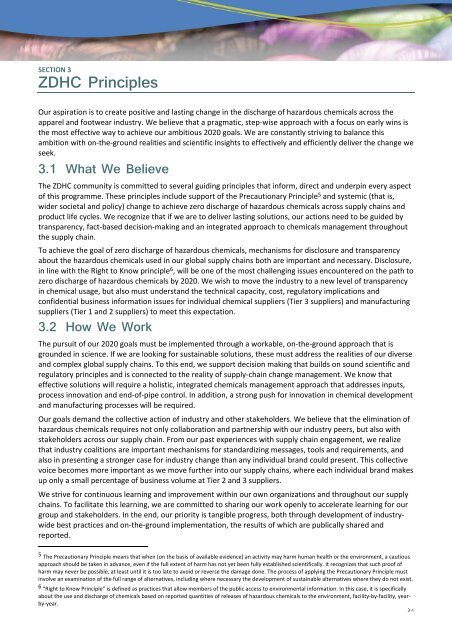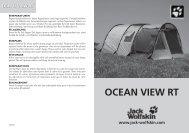The ZDHC Joint Roadmap - Jack Wolfskin
The ZDHC Joint Roadmap - Jack Wolfskin
The ZDHC Joint Roadmap - Jack Wolfskin
You also want an ePaper? Increase the reach of your titles
YUMPU automatically turns print PDFs into web optimized ePapers that Google loves.
SECTION 3<br />
<strong>ZDHC</strong> Principles<br />
Our aspiration is to create positive and lasting change in the discharge of hazardous chemicals across the<br />
apparel and footwear industry. We believe that a pragmatic, step‐wise approach with a focus on early wins is<br />
the most effective way to achieve our ambitious 2020 goals. We are constantly striving to balance this<br />
ambition with on‐the‐ground realities and scientific insights to effectively and efficiently deliver the change we<br />
seek.<br />
3.1 What We Believe<br />
<strong>The</strong> <strong>ZDHC</strong> community is committed to several guiding principles that inform, direct and underpin every aspect<br />
of this programme. <strong>The</strong>se principles include support of the Precautionary Principle 5 and systemic (that is,<br />
wider societal and policy) change to achieve zero discharge of hazardous chemicals across supply chains and<br />
product life cycles. We recognize that if we are to deliver lasting solutions, our actions need to be guided by<br />
transparency, fact‐based decision‐making and an integrated approach to chemicals management throughout<br />
the supply chain.<br />
To achieve the goal of zero discharge of hazardous chemicals, mechanisms for disclosure and transparency<br />
about the hazardous chemicals used in our global supply chains both are important and necessary. Disclosure,<br />
in line with the Right to Know principle 6 , will be one of the most challenging issues encountered on the path to<br />
zero discharge of hazardous chemicals by 2020. We wish to move the industry to a new level of transparency<br />
in chemical usage, but also must understand the technical capacity, cost, regulatory implications and<br />
confidential business information issues for individual chemical suppliers (Tier 3 suppliers) and manufacturing<br />
suppliers (Tier 1 and 2 suppliers) to meet this expectation.<br />
3.2 How We Work<br />
<strong>The</strong> pursuit of our 2020 goals must be implemented through a workable, on‐the‐ground approach that is<br />
grounded in science. If we are looking for sustainable solutions, these must address the realities of our diverse<br />
and complex global supply chains. To this end, we support decision making that builds on sound scientific and<br />
regulatory principles and is connected to the reality of supply‐chain change management. We know that<br />
effective solutions will require a holistic, integrated chemicals management approach that addresses inputs,<br />
process innovation and end‐of‐pipe control. In addition, a strong push for innovation in chemical development<br />
and manufacturing processes will be required.<br />
Our goals demand the collective action of industry and other stakeholders. We believe that the elimination of<br />
hazardous chemicals requires not only collaboration and partnership with our industry peers, but also with<br />
stakeholders across our supply chain. From our past experiences with supply chain engagement, we realize<br />
that industry coalitions are important mechanisms for standardizing messages, tools and requirements, and<br />
also in presenting a stronger case for industry change than any individual brand could present. This collective<br />
voice becomes more important as we move further into our supply chains, where each individual brand makes<br />
up only a small percentage of business volume at Tier 2 and 3 suppliers.<br />
We strive for continuous learning and improvement within our own organizations and throughout our supply<br />
chains. To facilitate this learning, we are committed to sharing our work openly to accelerate learning for our<br />
group and stakeholders. In the end, our priority is tangible progress, both through development of industrywide<br />
best practices and on‐the‐ground implementation, the results of which are publically shared and<br />
reported.<br />
5 <strong>The</strong> Precautionary Principle means that when (on the basis of available evidence) an activity may harm human health or the environment, a cautious<br />
approach should be taken in advance, even if the full extent of harm has not yet been fully established scientifically. It recognizes that such proof of<br />
harm may never be possible, at least until it is too late to avoid or reverse the damage done. <strong>The</strong> process of applying the Precautionary Principle must<br />
involve an examination of the full range of alternatives, including where necessary the development of sustainable alternatives where they do not exist.<br />
6 “Right to Know Principle” is defined as practices that allow members of the public access to environmental information. In this case, it is specifically<br />
about the use and discharge of chemicals based on reported quantities of releases of hazardous chemicals to the environment, facility‐by‐facility, yearby‐year.<br />
3-1

















